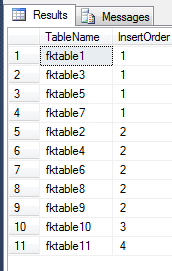Here's a script to determine, based on your database's foreign key relationships, what the insertion order would be for, say, a testing dataset.
with cteFK (pktable, fktable) as (
select
pktable = o1.name
, fktable = isnull(o2.name, '')
from sysobjects o1
left join sysforeignkeys fk on o1.id = fk.fkeyid
left join sysobjects o2 on o2.id = fk.rkeyid
where o1.xtype = 'u'
and o1.name not in ('dtproperties','sysdiagrams')
group by o1.name, isnull(o2.name, '')
), cteRec (tablename, fkcount) as (
select tablename = pktable
, fkcount = 0
from cteFK
UNION ALL
select tablename = pktable
, fkcount = 1
from cteFK
cross apply cteRec
where cteFK.fktable = cteRec.tablename
)
select
TableName
, InsertOrder = dense_rank() OVER ( ORDER BY max(fkcount) asc )
from (
select
tablename = fktable
, fkcount = 0
from cteFK
group by fktable
UNION ALL
select tablename = tablename, fkcount = sum(ISNULL(fkcount,0))
from cteRec
group by tablename
) x
where x.tablename <> ''
group by tablename
order by 2,1 asc
Use the sample script from the previous post on how to "Script Out Foreign Keys With Multiple Keys" for an example of building a complicated set of foreign key relationships to test this script out.
Here's the results from that example:
Similarly, this script would generate an order for you to unravel the data - the numbers descending would allow you to delete in the proper order,
delete from fktable11 delete from fktable10 delete from fktable9 delete from fktable8 delete from fktable6 delete from fktable4 delete from fktable2 delete from fktable7 delete from fktable5 delete from fktable3 delete from fktable1
... or drop the tables in the proper order.
drop table fktable11 drop table fktable10 drop table fktable9 drop table fktable8 drop table fktable6 drop table fktable4 drop table fktable2 drop table fktable7 drop table fktable5 drop table fktable3 drop table fktable1



